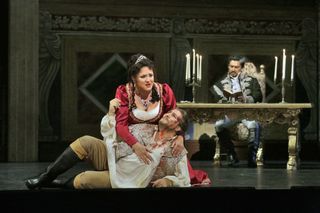|
Back
Three ‘Firsts’ in Season Opener Atlanta
Cobb Energy Performing Arts Centre
10/05/2013 - & 8*, 11, 13 October, 2013
Giacomo Puccini: Tosca
Kara Shay Thomson (Floria Tosca), Massimiliano Pisapia (Mario Cavaradossi), Luis Ledesma (Baron Scarpia), Tyler Simpson (Sacristan), Jason Eck (Angelotti), Adam Kirkpatrick (Spoletta), Andrew Cummings (Sciarrone), Mitchell Jones (Jailer), Megan Mashburn (Shepherd)
The Atlanta Opera Chorus, Jennifer Langley (Children’s Chorus Master), Walter Huff (Chorus Master), The Atlanta Opera Orchestra, Peter Ciaschini (Concertmaster), Arthur Fagen (conductor)
Tomer Zvulun (Stage Director), Andrew Horn (Scenic Designer), Lena Rivkina (Costume Designer), Robert Wierzel (Lighting Designer), Richard Jarvie (Wig and Makeup Designer)

(© Ken Howard)
Atlanta Opera opens its 2013-2014 season with the veritable ‘war horse’ Tosca after an absence of seven years. This opulent Andrew Horn designed production carries with it significant ‘firsts’ featuring debuts of the three principal roles. And while many critics viewed the January 14, 1900 opening of Giacomo Puccini’s ‘shabby little shocker’ as strikingly violent, this Tomer Zvulun led staging is respectfully tame with an expectant, broad scope.
Arthur Fagen leads a well-rehearsed, clean-diction orchestra that introduces us to Jason Eck’s (also making his Atlanta Opera debut) beautiful bass voice despite being dwarfed by periodic fortissimo moments. Shortly following is Tyler Simpson who fills the holy shoes of the Sacristan. Simpson’s résumé is stellar, having garnered attention at The Met with four consecutive years of multiple performances; he has a broad and stalwart bass-baritone register that brims with richness while curtailing any overt gesticulations.
For a man so diminutive in build, Massimiliano Pisapia clearly packs a punch of irony, for his lirico spinto voice folds smoothly into Puccini’s notes with effortless resolve. The challenges in singing Cavaradossi come quickly in Act I when up against “Recondita armonia”, but Pisapia is prepared, precise and pristine. Following a rather tentative (last minute cast change) rendition of Megan Mashburn’s shepherd voice initiating Act III, we hear Fagan’s orchestra soon leading into Cavaradossi’s poignant aria, “E lucevan le stelle”, that radiates with emotive flair and charisma. Pisapia simply shines with unequivocal energy, evoking heightened frisson.
Kara Shay Thomson is quite the established Tosca: her range and approach are well groomed as a dramatic soprano with a metallic edge, the voice carries with exponential force even though she appears tightened at times in the upper register. After the tousle with Scarpia, she expends so much energy that upon entering her showcase stopper, “Vissi d’arte”, she begins with wonderful controlled breathing only to lose steam half way through. Bathed inside Robert Wierzel’s transitional blue lighting, Thomson speeds up the tempo (to get through it quickly) which Fagan fails to match. Despite such a patchy moment, Thomson manages to regain her stamina and finish the aria with a satisfying finish.
Where there appears to be a ‘chink in the armour’ is with Scarpia, performed by Luis Ledesma (replacing Mark Delavan on a month's notice), not so much in vocal ability, but in the acting department. Behind his music, however, a lecherous, sinister man fails to jump out of the woodwork. Ledesma appears more like a ‘cardboard character’, and it is especially noticeable when making a feigned attempt to rape Tosca in Act II. The result is flat and unrealistic.
One of the most powerful moments in Tosca revolves around the chorus. Closing the curtain on Act I is the famous Te Deum that Puccini heats up in a mixture of parts, coming together like a mighty tsunami. Equally satisfying is the offstage cantata choral section of Act II.
As with visual effects, the gunshots fired in Act III are very real and dramatically stimulating. Smoke is seen wafting through the air which adds to the overall eeriness and creepiness of this Tosca. The blood from Scarpia’s stabbing and Cavaradossi’s stained shirt following the ‘mock’ execution (as well as wounds from his torture) are mildly convincing. Perhaps it’s ‘toning down’ to a more conservative audience. Tosca’s parapet jump is tepid.
So here we have a pretty credible Tosca, but in comparison to a three-legged footstool, one leg is a tad hollow, weakening the overall structure. It’s still a thrill and an enjoyment.
Christie Grimstad
|